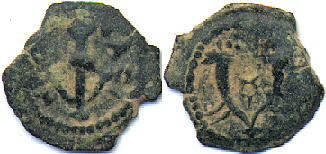Herod I , King of Judea (Herod the Great)
Born c. 73 B.C. , King of Judea, 37 B.C. - 4 A.D.

Copper, 24 mm
O: Tripod, holding ceremonial vessel
R: Helmet surmounted by star
This coin is believed to be struck c. 40 BC, after Herod was proclaimed ruler
of Judea by Rome, but before he and the Romans toppled the Hasmoneans and
captured Jerusalem (37 BC).

Copper, 14 mm.
O: Anchor. Greek inscription "of King Herod".
R: Double Cornucopia with caduceus between.


Copper, 12 mm.
O: Eagle standing to right.
R: Cornucopia. Greek inscription "of King Herod".
When Herod was done restoring the Temple in Jerusalem, he affixed a golden
eagle to the Temple gate. That eagle is shown on this coin, the first
coin issued by a Jewish ruler with a graven image upon it.
Herod I was made king of Judea by the Roman Senate (40 BC) and ruled from
Jerusalem after 37 BC, following the defeat of the last of the Hasmonean
Dynasty (descendants of Judah the Maccabee).
Herod was of Idumaean descent, his family converted to Judaism a few generations
before. As such, he was fundamentally different from the bulk of his
Jewish subjects, and ruled entirely by the authority of Rome. An
imperious king and capable general, Herod promoted Hellenization among the
Jews. He was the first Jewish ruler to issue coins with inscriptions
entirely in Greek. He founded the city of Caesaria and rebuilt much of
Jerusalem, including the Temple. He was notoriously cruel, and executed
three of his sons and his second wife. It is said that when Augustus heard about the executions, he exclaimed, "It
is better to be Herod's pig than his son!" In the New Testament,
Herod is depicted ordering the slaughter of newborn children of Bethlehem
("slaughter of the innocents") in his attempt to kill the the newborn
Jesus.